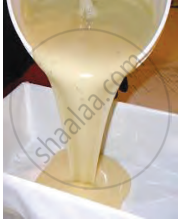4. Conclusion: In this experiment, fat (from coconut oil) reacts with alkali (sodium hydroxide) to form soap, which is a sodium salt of fatty acids. Soap floats on water and solidifies upon cooling, forming a usable soap bar.

Making soap
Soap is a chemical compound that forms as a salt of fatty acids or other carboxylic acids. It is widely used for cleaning, lubricating, and a variety of other applications. In households, soaps, particularly toilet soaps, serve as surfactants for washing, bathing, and general cleaning tasks. In industrial contexts, soaps are utilised as thickeners, emulsifiers, components in lubricants, and even as catalysts in certain chemical processes.
| Feature | Hard Soap | Soft Soap |
|---|---|---|
| Raw Material | Low-grade fats and oils | High-grade fats and oils |
| Use | Washing clothes | Bathing and skincare |
| Composition | Sodium salts of fatty acids | Potassium salts of fatty acids |
| Texture | Hard and solid | Soft and smooth |
| Skin Effect | Not suitable for skin | Gentle on skin |
| pH Level | Higher pH for effective grease removal | Close to skin’s natural pH |
| Texture | Hard and solid | Soft and smooth |
| Effect in Hard Water | Forms scum and loses cleaning power | Works better on skin with soft water |
Synthetic detergents are cleaning agents made through chemical processes. They are different from soaps and are commonly used today because they work well even in hard water.
1. Aim: To prepare soap by combining fat (coconut oil) and alkali (sodium hydroxide).
2. Requirements: 15 g sodium hydroxide (NaOH), 60 ml coconut oil, 15 g salt, perfume, water, beaker, glass rod, tripod, wire gauze, burner, and mould.
3. Procedure
